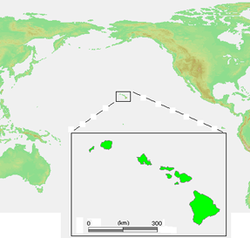Paulet Affair (1843)
| Provisional Cession of the Hawaiian or Sandwich Islands | ||||||||||
| Unrecognized colony of the British Empire | ||||||||||
|
||||||||||
|
Anthem God Save the Queen |
||||||||||
|
Location of the Hawaiian islands.
|
||||||||||
| Capital | Honolulu | |||||||||
| Languages | English, Hawaiian | |||||||||
| Government | Provisional government | |||||||||
| Monarch | ||||||||||
| • | 1843 | Queen Victoria | ||||||||
| Local Representative | ||||||||||
| • | 1843 | George Paulet | ||||||||
| • | 1843 | Richard Thomas | ||||||||
| Historical era | International relations of the Great Powers (1814–1919) | |||||||||
| • | Established | February 25, 1843 | ||||||||
| • | Disestablished | July 31, 1843 | ||||||||
|
||||||||||
The Paulet Affair was a five-month occupation of the Hawaiian Islands in 1843 by British naval officer Captain Lord George Paulet, of HMS Carysfort.
Paulet had become captain of HMS Carysfort on 28 December 1841, serving on the Pacific Station under Rear-Admiral Richard Darton Thomas (1777–1857).
Richard Charlton, who had been the British Consul to the Kingdom of Hawaii since 1825 met Paulet off the coast of Mexico in late 1842. Charlton claimed that British subjects in the Hawaiian Islands were being denied their legal rights. In particular, Charlton had a claim to land that was under dispute. Paulet requested permission from Admiral Thomas to investigate the allegations.
Paulet arrived at Honolulu and requested an audience with King Kamehameha III on 11 February 1843. He was told the King was on another island and would take six days to arrive. His next letter on 16 February, although keeping the polite tone of formal diplomatic correspondence, becomes a bit more demanding:
"I have the honour to acquaint your Majesty of the arrival in this port of Her Britannic Majesty's ship under my command, and according to my instructions I am desired to demand a private interview with you, to which I shall proceed with a proper and competent interpreter."
...
Wikipedia


